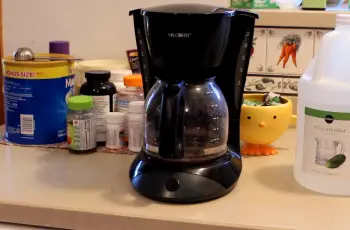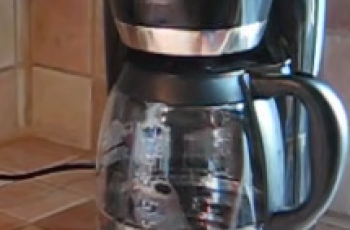There is nothing better than having a hot cup of coffee in the morning, and most people drink coffee in the morning. Sometimes, you may be tempted to add hot water to your coffee maker to speed up the cooking process. But as it turns out, you should never do that. Coffee makers are designed to heat the cold or room temperature water to the right temperature for the drinking process. If the water is too hot, it can run off the hot water pipe and overfill your coffee filter basket, which can lead to dirty cleaning and potentially harm your coffee maker. Also, it will take away your coffee grounds and leave you with a bitter cup of coffee.
If you’ve ever made soup, you already know how important flavors and proportions are. If you put too much broth or water in the pot, the soup may get a thin and watery taste. And if you add too little broth or water, the soup can taste too thick and heavy. This is a delicate balancing act. But if you get it right, you will have the perfect proportions of a great-tasting bowl. The same principle applies to coffee making. Adding plenty of ground and water to your machine can really make or break your coffee. These are just two ingredients to make coffee. Which makes it very important to find the right balance between the two.
All over the world, millions of people are producing coffee so that they can increase their production and be vigilant. Coffee lovers may find it a bit more dramatic and say they can’t do better without it. That’s why there are coffee shops in every corner and corner. However, one does not have to spend that much money to drink good coffee. Thanks to the user-friendly coffee makers. Still, others don’t know how he operates and even asks, “Where do you put water in the coffee maker?”
Where Do You Put Water In A Coffee Maker
Most people have a way of determining the ratio of water to coffee. But there is a big difference in comparing their accuracy. Here’s how to put one together for use with your eyeballs. Some people use the “scope” method, measuring the amount of ground coffee according to the number of scoops and filling the machine’s water reservoir from the amount of water before the set line. But the most accurate way to measure coffee and water is to use a scale, which gives all the estimates involved in determining the right amount of coffee and water for the machine.
No matter how you measure your coffee and water, you should always have a coffee to water ratio of 16: 1. In other words, you should have 16 parts water for every 1 part coffee. It looks like coffee, not coffee. But that’s the proportion that the Specialty Coffee Association has committed to being the “golden ratio” for coffee drinking. Numerous studies show that this is the ideal ratio for almost all human palms, regardless of whether you are an experienced barista or a regular coffee drinker. And while this ratio varies slightly with the cooking tool, it is a good starting point for home enthusiasts, whether you have your own automatic drip coffee machine, Camax, French press, or aero press.
The Basic Steps of Coffee Making
It is not enough to have a coffee maker. One also needs the coffee grounds as well as the filter basket. There are different kinds of coffee filters like bleached, natural, and non-generic. Many coffee lovers would suggest that using non-generic coffee filters is the best option. However, do take note that plenty of coffee makers have their built-in coffee mesh filters. In many cases, one can still use a coffee filter to make cleaning easier.
To start making a great brew,
Step 1: Place the coffee filter in the coffee filter basket.
Step 2: Take out the coffee and start measuring. How much coffee you need to put in depends on your taste the kind of coffee grounds you are using. After all, some coffee grounds are stronger than others.
Step 3: Know the ratio of the water to the coffee. This depends on one’s preference as well as the kind of coffee maker. Usually, the ratio is two tablespoons for every six ounces of water. However, one also has to check the user guide of the maker on the recommended coffee to water ratio as well as the coffee ground’s advice.
Keep in mind that there are special blends of coffee ground that will require different water-to coffee ratios. These blends would have their instructions for drinkers in their packages. Make sure you are using the correct measurement such as using a tablespoon if the instructions say to use one rather than a teaspoon. This is because getting incorrect measurements may affect the taste of the coffee.
Where Do You Put The Water in a Coffee Maker: Measuring the Water Is Important
Step 4: After adding and measuring the coffee grounds, then it is now time to deal with the water. Most, if not all coffee makers have measurement lines either on the side of the coffee maker or found inside the coffee pot. Now pour the water into the coffee maker. But where do you put the water in a coffee maker can be quite confusing.
Many first-time coffee brewers make the mistake of pouring the water into the filter basket. This is wrong as the water must be poured into the water compartment rather than on the coffee basket. This mistake, however, is understandable as water is often poured over powdered coffee, but the process for brewed coffee is different.
Step 5: After placing the water in its right place, then place the coffee pot again on the warming plate.
Operating the Coffee Maker
Step 6: After measuring the coffee and placing it on the filter and measuring the water, then it is time to turn on the coffee maker. Keep in mind that coffee makers are built differently as some are automatic while others require manual settings of the time.
If you are the type who dislikes having to do time setting manually, then it is best to buy an automatic or electric one. Regardless of the kind of coffee maker bought, one has to read the instruction guide for safety purposes and device longevity as well. Moreover, some coffee makers have a pause button, which allows users to stop the brewing process midway. Such a feature is useful if one can not afford to wait for the coffee to brew completely.
Step 7: After you are done brewing the coffee, then it is time to clean up the pot. Throw away the paper coffee filter if you used one as failing to do so will make the coffee from the pot taste bitter later on. If you used the built-in filter, then wash it after you have taken out the coffee ground. Washing is important as leaving used coffee grounds will affect the taste of succeeding brewed coffee.


